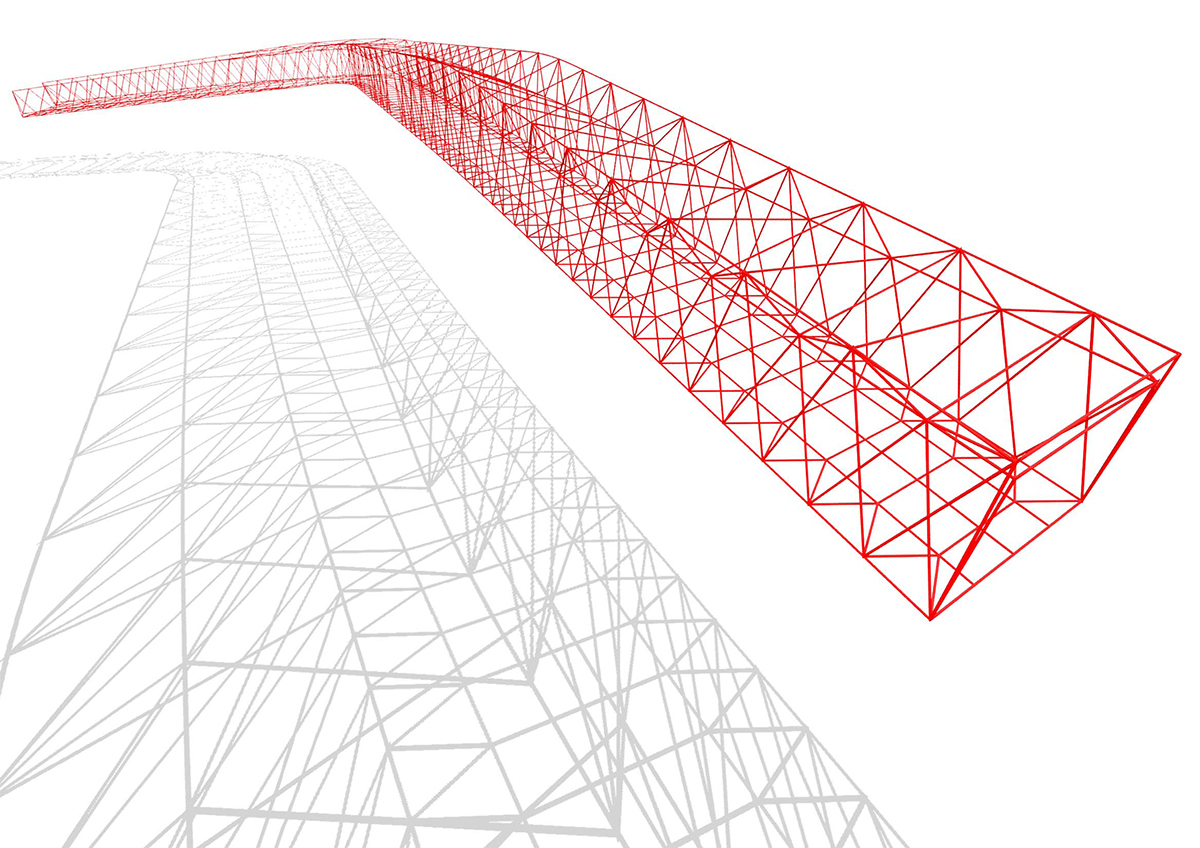

Landscape bridge + Cityscape bridge = Aarschot bridge
The new bicycle and pedestrian bridge over the railway tracks in the town of Aarschot, close to Brussels, fulfills many functional needs. It connects the old fabric with the new industrial and business developments at the other side of the railway line. It connects the town to the regional bicycle path system and to the green areas surrounding it. And finally, it provides new accesses to the station´s platforms. The bridge also reacts to its context. At the Elzenhof Park side, it turns into a landscape, a hill planted with grass where hedges are used as railings. This artificial hill ecologically reuses the removed soil in all the nearby construction sites.At the town center side, the bridge blends into the cityscape, and consists of a ramped roof building housing an indoors bicycle parking. This building is clad with a roughly finished local stone, and offers an urban facade to the station square.Finally, the span over the tracks is a delicate, trellis-like structure which gives the bridge a sophisticated and strong presence. It turns it into a beacon in the city.
The new bicycle and pedestrian bridge over the railway tracks in the town of Aarschot, close to Brussels, fulfills many functional needs. It connects the old fabric with the new industrial and business developments at the other side of the railway line. It connects the town to the regional bicycle path system and to the green areas surrounding it. And finally, it provides new accesses to the station´s platforms. The bridge also reacts to its context. At the Elzenhof Park side, it turns into a landscape, a hill planted with grass where hedges are used as railings. This artificial hill ecologically reuses the removed soil in all the nearby construction sites.At the town center side, the bridge blends into the cityscape, and consists of a ramped roof building housing an indoors bicycle parking. This building is clad with a roughly finished local stone, and offers an urban facade to the station square.Finally, the span over the tracks is a delicate, trellis-like structure which gives the bridge a sophisticated and strong presence. It turns it into a beacon in the city.

Strategies
The new bridge connects to the surrounding green areas, to the regional bicycle network, and to the new developments at the other side of the railway tracks. It also completes the station square with an urban façade.

Site specific
The bridge responds to the context: the urban side is a building, the lanscape side is a hill, the span over the tracks a lightweight scultpture.

General plan at sidewalk level and elevation from west

General plan at bridge deck level and elevation from east

Bridge plan and elevation

Trellis!
Instead of a massive triangulated steel beams structure, the same amount of metal is put into a thin tube structure, resulting in 779 cilindrical tubes 11cm in diameter.The trellis is formed!

Bridge Sections
The height of the bridge profile changes with the span: the longer central span profiles are thus higher.

Inside the trellis!
A perspective effect: the trellis appears viually permeable at the forground, and it closes up at the background, turning almost into a tub
A perspective effect: the trellis appears viually permeable at the forground, and it closes up at the background, turning almost into a tub

Typical details
The baluster needs to be 1,80m high when over the tracks, for security reasons. At the abutements, its height can be reduced to 1,20. The baluster is composed of an outer glass sheet that reaches the normative height, and of an inner wooden railing attached to a vertical steel plate structure that also holds the glass sheets.

Torsioned columns
The columns have to solve a geometric issue: the axis of the platforms are not perpendicular to the axis of the bridge, but at an angle. This means that the columns need to torsion to manage the transition. The torsioned geometry is solved by means of a triangulation of the column’s faces.

Columns' genealogy
The final shape of the columns is the end of a process, where aesthetic clarity and engineering needs have to merge. So, copious studies are produced: columns that are alone, or incorporate the stairs, more or less massive, more or less dynamic, more or less complex.

Columns' family
The spanning part of the bridge is supported by 5 columns, 8m high aproximately. One of them has two arms, the others three arms. Some are higher, others lower. One is at the curve and the position of the support points is inverted. All these geometrical situations are answered within a family of triangular faced torsioned columns that adapt to each case.

Columns and stairs
The stairs are supported by the bridge structure, and are separated from the columns. Thus, it is possible to use the same syntax in all the columns.The stair’s structure is conformed by a central steel plate beam. The steps are cantilevering at both sides of this beam and are prefab concrete pieces fixed to the top of the steel beam.
The stairs are supported by the bridge structure, and are separated from the columns. Thus, it is possible to use the same syntax in all the columns.The stair’s structure is conformed by a central steel plate beam. The steps are cantilevering at both sides of this beam and are prefab concrete pieces fixed to the top of the steel beam.

Between the columns
View of the bridge from below, revealing the column family.
View of the bridge from below, revealing the column family.

